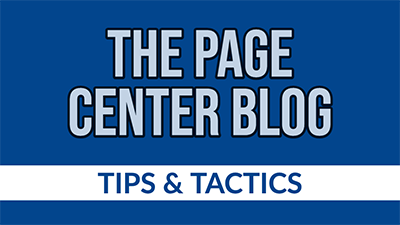Page Center blog guidelines
Thank you for contributing to the Page Center blog. 
The blog is an opportunity for Center audiences to hear from our scholars. Our goal is to showcase you, your research and the topic in layman's terms so a general audience of readers can grasp the scope, results and practical uses of your work.
Below are guidelines to help you along. Several examples of past blog posts are included as well. If you have any questions about blogging for the Page Center, contact Jonathan McVerry at jmac@psu.edu.
Blog #1 - Q&A
For the first blog, the lead author of the project will spend 20 to 30 minutes discussing their research interests, the research topic from their perspective, the story behind their collaboration (if there is one), and their ideas/plans for the upcoming project. Page Center staff will organize the interview early in the grant period. They will compile the discussion into a Q&A-style story for the blog. Scholars will have an opportunity to review before publication.
Each post will break down into three general parts: 1) Introducing the research team and its origin story, 2) explaining the topic and where it currently stands in the literature, and 3) sharing the research plan and possible results/future steps (if applicable). Scholars should be prepared to introduce the topic to the interviewer. They should also be ready to share practical uses of the research and their motivation for conducting this important work.
Blog #2 - Scholar post
The second blog post will be written by the research team and will be due upon the completion of the project. It will cover the results of the study. The goal of the Page Center is to bridge our scholars' academic work with the profession. Blog #2 should be written with practical language for a practioner audience. We like to share results in a way that inspires best practices across the industry. Scholars should lead with what they think is the most interesting aspect of their study. They should tell the story of the project. What surprised them most? What are future steps? Most importantly, what are the practical takeaways? This post will focus more on what's new than past research/literature.
Guidelines for Blog #2
1. Be conversational
We want users to finish reading your write-up with a decent understanding of your work. Have fun with it. Imagine you are explaining your project to a new friend at a party. Share a story about your project. Use real world analogies. Use first person (I, we, our). Lead with the most interesting information.
2. 500 words
The ideal length of a blog post is 500 words. No more than 800. If you are having trouble cutting words, let us know and we can help edit. There may also be opportunities to break the write-up into multiple posts.
Anecdoates, examples, images, links and lists are encouraged.
3. For a general audience
Echoing the first point, avoid using jargon an average reader may have trouble understanding. In addition to the general audience, we fund projects from a range of disciplines so our readers may include faculty/practioners from several fields unfamiliar with your expertise's vocabulary. Feel free to include links to additional reading in case readers want to read more about your topic. Please do not to use citations.
4. The future
Be sure to include the practical uses of past research and your research, and what it means to the field. Also, what are your next steps? How does the current project fit into those next steps? What would future research look like? What new questions need to be answered?
Examples of Page Center blog posts
Blog #2s
U.S. employees not satisfied with listening efforts of management
Marlene S. Neill and Shannon A. Bowen
Attention social media managers! Stakeholders expect you to listen
Sarah Maben and Chris Gearhart
Are authenticity and vulnerability a new paradigm for women in politics?
Stephanie Madden and Abbey Levenshus
How corporations can survive a fake news crisis
Michele E. Ewing and Cheryl Ann Lambert

